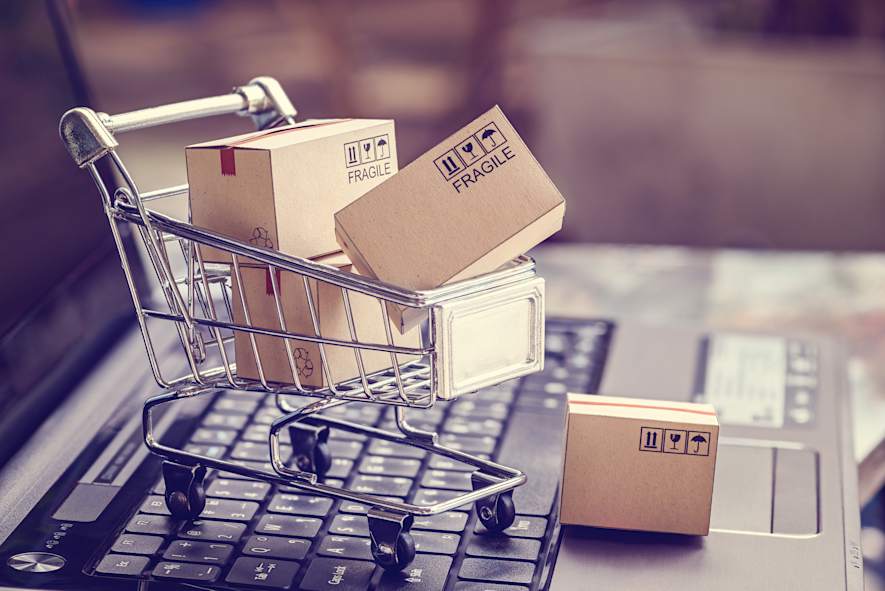
Starting your own business
Entrepreneurship in 2026: Inside the UK’s growing appetite for self-employment
Simple, smart accounting software - no commitment, cancel anytime

ECOMMERCE
You might be wondering why we’re writing an article about this. After all, we’re in the accountancy business. But we do have a marketing department of our own and we also talk to a lot of QuickBooks users, so we have some pretty expert knowledge on our side, which we want to share with you.
So, you want to start selling online? It could be one of the best decisions you make for your business. Follow our top tips and make sure your ecommerce site has what it takes to succeed.
Your website is the shop window of your brand, so make sure it creates an outstanding first impression. Investing in the right website platform is a crucial step towards the future success of your business. If you’re not sure where to start, take a look at a few of the most popular ones - Zoey, Shopify, BigCommerce and WooCommerce..
Regardless of which platform you choose, you’ll also need to make sure you consider these key points:
Usability is key. Your navigation should be intuitive, making it easy to search for products and complete transactions.
Mobile friendly. It has to be (unless, that is, you want to miss out on sales).
It’s natural to breathe a huge sigh of relief when you’ve finished your website, but in fact, this is just the start. Regular updates are an essential part of ecommerce, whether you’re changing your product range, introducing a new offer or just livening things up a bit to keep your customers interested. Make sure you choose a platform that makes editing easy.
When you’re starting an ecommerce business, it’s essential to display your products in the very best light. Don’t be tempted to save time or money on photography – after all, the images you put on your website are the only thing your customers will see.
Hire a professional photographer to do the job, or if you have talent (and a decent camera) invest a few hours in getting the images right. And always include a zoom feature in your images if you can - it removes a lot of guesswork from the shopping experience.
Once your site is up and running, you’ll need to spread the word.
Make sure your site is visible to people searching on Google by getting the SEO (Search Engine Optimisation) right. Read more about SEO in our related ecommerce article.
Email marketing is cheap, and you can personalise your messages. Mailchimp is a great platform for this.
Use social media such as Instagram, Twitter and Facebook to shout about your latest products or promotions. Advertising on social media is a perfect way to reach a wide audience, and quickly.
Everyone loves a bargain, so make sure your ecommerce site offers regular discounts. Standard savings will encourage customers to come back to your site, but try ‘upselling’ or ‘cross selling’ too. Offering money off to customers who buy more or higher value products boosts average order values and overall sales. If you’re using frequently changing discount codes, remember to set them as ‘active’ or ‘inactive’ to avoid confusion and costly mistakes.
It’s important to make sure you cover your postage costs and use a reliable delivery firm. But, remember, if you overcharge you’ll start losing customers. Free postage is always a draw, but it makes sense to link this to a minimum order amount - you’ll encourage extra sales that way as well.
For simplicity, most ecommerce sites have a fixed postage price, so calculate the average cost for the parcels you send. It’s a good idea to speak to a few delivery firms first, to get a competitive price.
It’s easy to make a connection with customers when you interact with them in person, but it’s quite a challenge when you’re selling online. Loyalty schemes are a great way to show your appreciation and keep customers coming back for more - so consider introducing one. Take any opportunity you can to make the shopping experience special, too – if your order fulfilment is done in house, consider adding a personal note to say thank you.
When you’re starting an ecommerce business, it’ll be a small-scale operation at first. But be prepared for success. If everything goes well and you start selling in larger quantities, you’ll be glad you have a plan. Make sure your ecommerce platform can cope with a larger volume of orders, or an increase in the range of items you offer. It’s essential to keep an eye on stock levels too, so you’re prepared for speedy fulfilment if and when things really take off.
Plenty of websites attract interest but ultimately fail, usually through lack of attention to detail. The ‘abandoned cart’ is a clear sign that something’s going wrong, so keep an eye on sales in progress. Be prepared to send a friendly email to customers who don’t complete their order, and have another look at your check-out to make sure it’s as simple as possible. Offer a range of payment options, such as PayPal, which you can link directly with QuickBooks online accounting software, automating much of the process and saving you a lot of time.
Remember, however beautiful your ecommerce website looks, if you want to succeed, the focus should always be on sales.
Did you find this article about starting an ecommerce business useful? The QuickBooks blog covers many more topics. It’s all part of the support we offer to small businesses in the UK.
Subscribe to get our latest insights, promotions, and product releases straight to your inbox.
9.00am - 5.30pm Monday - Thursday
9.00am - 4.30pm Friday